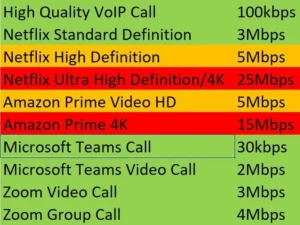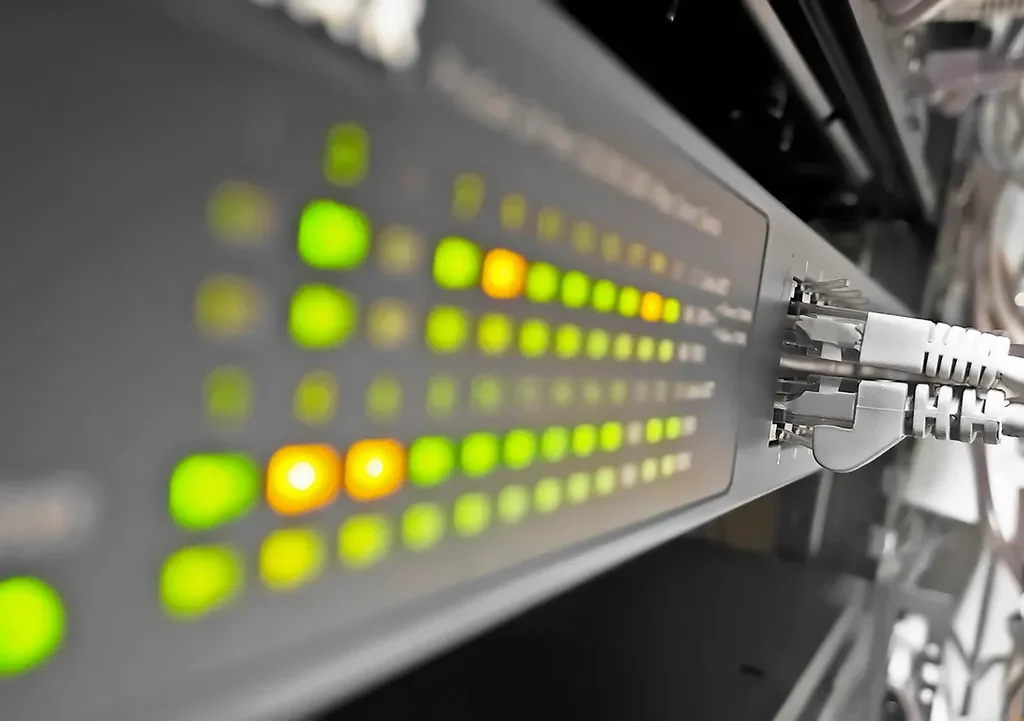There’s a common trend for people to chase ever increasing numbers for their internet connectivity. Speed test apps have given bragging rights to many consumers, showing off super high speeds, but what if you don’t need all of that bandwidth?
A simple analogy would be having a car that’s capable of a top speed of 180 miles per hour, yet only ever driving it to the shops and back on roads restricted to 50.
So, how much bandwidth do you really need? The answer depends on usage and the number of devices trying to access information outside of the local network. In this blog we will look at the two very different usage scenarios: commercial and residential.
Residential
 Your typical home internet connection is likely to be some kind of DSL service, delivered over a cable into your property. In most cases this is an asymmetric service, meaning the download bandwidth is higher than the upload, and there’s a very good reason for this.
Your typical home internet connection is likely to be some kind of DSL service, delivered over a cable into your property. In most cases this is an asymmetric service, meaning the download bandwidth is higher than the upload, and there’s a very good reason for this.
In most cases home use is largely made up of content being downloaded from the internet. Content is consumed by the users in a property in the form of music, video and images which are displayed onto their devices. The upload traffic is minimal and usually only consists of requests for traffic to start streaming or downloading. The only things likely to cause a surge in upload traffic would be sending emails with attachments, uploading photos and videos to social media, video calls, and to an extent, online gaming.
The download element is far more critical. Simple web browsing can be image heavy and it’s this that is far more noticeable to the end user. Some of you may remember the early days of the internet when a page had to load bit by bit, sometimes taking several minutes.

To work out what realistic internet bandwidth you will require you just need to think about the usage scenarios you might be facing. If you live alone and you don’t have a 4K television, do nothing more demanding than a bit of social media surfing, then it’s unlikely that having 80Mbps internet is going to make a great deal of difference to you. On the other hand, if you’ve got a family of two adults and three children it might be a little different. In a worst case scenario it’s likely that Dad will be upstairs watching the football on Amazon Prime, Mum downstairs watching Bridgerton on Netflix in 4K, two of the kids online gaming and another in a group zoom call. That soon adds up to around 50Mbps of download bandwidth and 10Mbps of upload.
Will 300Mbps be any different to 100Mbps in that scenario? The simplest answer is, no. All of the spare bandwidth will be mostly idle. It’s only ever going to be tested if you’re downloading large files, in which case it will be a bit quicker, but the difference is usually marginal. A 4GB movie file is likely to take around six minutes on a 100Mbps connection, on a 300Mbps connection that time is reduced to around 3 minutes.
Business Use

In a business environment the balance between download and upload traffic is a bit more equal.
For a business that has migrated to cloud based data storage and applications it probably means there will be more traffic through your internet connection as your users access that data. If your infrastructure is still mostly on premises there will be less traffic.
You will likely have a lot of users on site sending and receiving emails, possibly making video calls and still using general internet browsing bandwidth. A business that has 100 users will use way more bandwidth than a business that only has 15.
Consider the types of traffic the business is generating. A digital marketing agency, for example, is likely to be consistently sending and receiving (or uploading and downloading) huge video or image files, generating vast volumes of traffic. Compare this to a veterinary surgery where most of the work being carried out is physical and the internet is only used for administration functions, creating a relatively small volume of traffic.

Contention
Ah yes, contention. With the majority of residential connections the backbone is shared between lots of users in the local vicinity. This means at peak times the actual bandwidth available to you may be much lower than promised.
Imagine the number of cold water taps in a large house. If you turn one on full the water will come out very quickly. If you then turn on another it’ll still come out quickly from both taps. If you turn on ten taps the water pressure drops and the rate of flow decreases.
With an ethernet leased line you are connected directly to the internet, all of the bandwidth is available all of the time.
The all important speed test

Ideally any speed test should be run directly from the router, straight out to the internet, and with no other devices connected. Many new routers will give you a speed test result from the built in admin page.
If that’s not available the next best option is a laptop or computer wired directly into the router. If you start adding devices such as power line adapters, WiFi bridges, mesh networks or old switches then this could drastically impair the results. The same can be said for running speed tests from mobile devices. Any amount of interference, from things like microwave ovens, neighbouring WiFi installations, or even simply long distances from the access point, can have a significant impact on the results. What might look like a poor internet connection might only be a poor connection between your mobile and the router.
Litenet Ltd are a provider of ADSL, Fibre, Leased Line and 4G internet connectivity. We have extensive experience in providing connectivity to businesses and rural locations across the country. If you need help, advice or would like to order a connection at a very competitive price, get in touch! info@litenetuk.com



